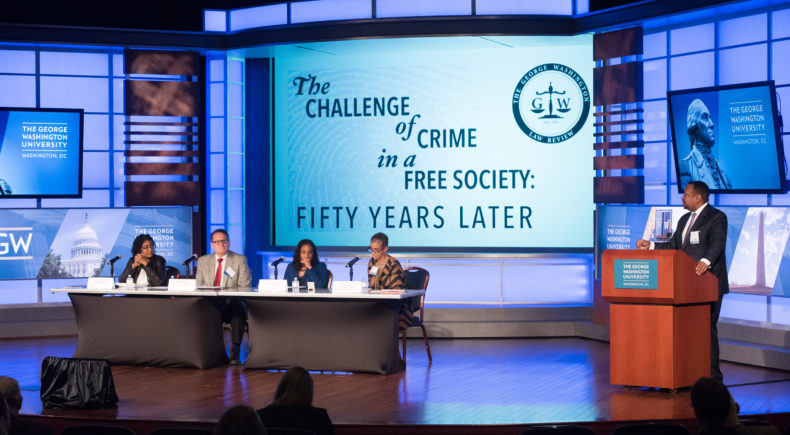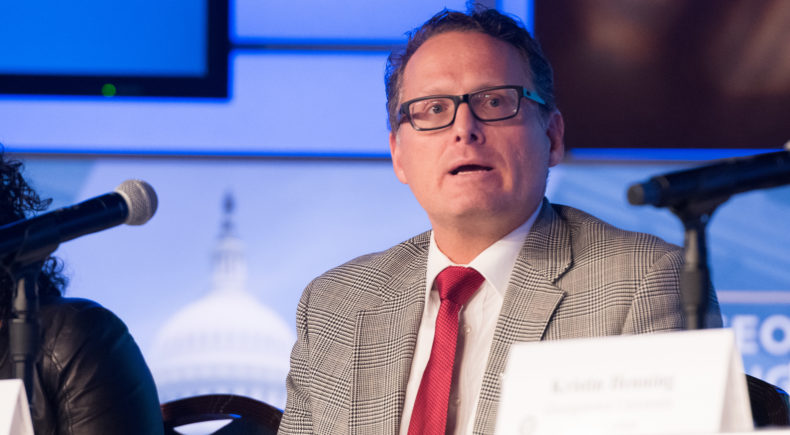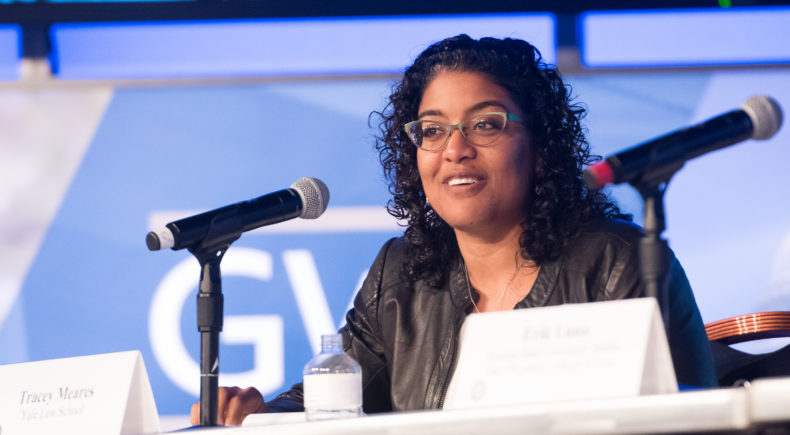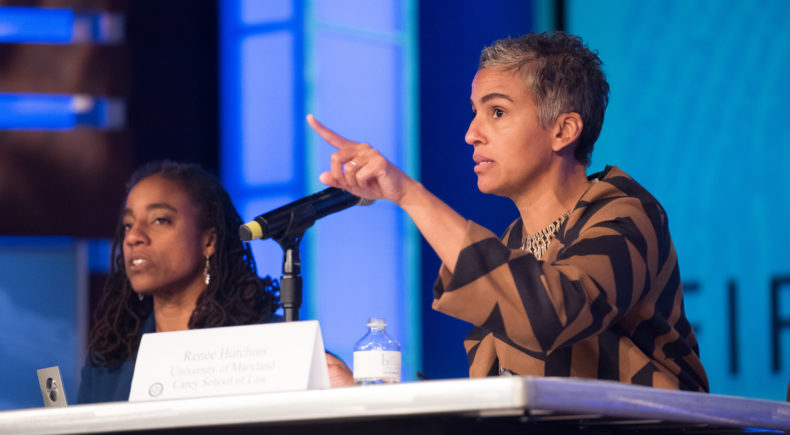Symposium 2017 | Policing of Vulnerable Groups
George Washington University Law School Associate Dean Roger Fairfax began the panel entitled “Policing of Vulnerable Groups” by introducing moderator Professor Renee Hutchins (Jacob A. France Professor of Public Interest Law and Co-Director of the Clinical Law Program at the University of Maryland’s Carey School of Law) and panel members Professor Kristin Henning (Agnes N. Williams Professor of Law and Associate Dean for Clinics at Georgetown University Law Center), Professor Erik Luna (Amelia D. Lewis Professor of Constitutional and Criminal Law at Arizona State University’s Sandra Day O’Connor College of Law), and Professor Tracey Meares (Walton Hale Hamilton Professor of Law at the Yale Law School and Founding Director of The Justice Collaboratory).
Professor Kristin Henning began the discussion by critiquing of the nation’s failure to live up to the goals of the 1967 Johnson Crime Commission’s Report. Quoting directly from the Report, Professor Henning took note of one of the Report’s aspirational goals, “America’s best hope for reducing crime is to reduce juvenile delinquency.” She explained that youth crime had increased markedly in the years leading up to the Report, and further observed that even though juveniles aged eleven to seventeen then made up only 13% of the population, they accounted for 50% of the arrests for property-related crimes. The Report blamed the spike in youth crime on parental and institutional failure and on poverty. Though Professor Henning noted that youth crime has fallen dramatically in the past two decades, neither the nation nor the Report has confronted the existence or the impact of racial disparity in law enforcement as it affects juveniles. “I don’t think,” Henning said, “it is hyperbole to say that racial equity and racial justice has never been possible in American juvenile justice.”
Professor Henning then traced the “historical eras” of juvenile justice, harkening back to the earliest days of our criminal justice system when virtually no distinction was made between adult and juvenile crime (and when blacks were not afforded meaningful justice), to the era of “rehabilitative justice,” when the focus was to reform and remake the offender (again excluding blacks for the most part), to the due-process era (which was laudable but overlooked the problems peculiar to race), to the tough-on-crime law-and-order era (and the birth of the racially-charged term “juvenile super-predator”). Professor Henning argued that America has recently entered another era: we have begun to recognize that juvenile defendants are developmentally different from adults and accordingly receive mitigated sentences. She claimed, however, that black youth are not receiving these benefits because of implicit racial bias. Professor Henning pointed to enhanced public fear of black youth, the likelihood that the actual ages of black youth are routinely overestimated, and the high frequency of black youth interaction with law enforcement. She recommended decriminalizing certain non-violent behaviors and increasing community engagement as the first steps to achieving racial equity in juvenile policing.
Professor Erik Luna spoke next, addressing the relationship between racial or religious bias and the fight against terrorism. He noted that preventing terrorist attacks requires “pro-active policing,” because the consequences of allowing a terrorist act are inherently grave. The difficulties in predicting terrorist behavior, he said, have resulted in “substance and process” giving way to the use of “race and religion” as a convenient proxy for choosing suspects— “dark and different equals dangerous.” Identifying “suspect communities,” however, perpetuates discrimination against the members of those communities and perpetuates their alienation.
Professor Luna provided a short history of the scapegoating of suspect minority classes, from the “red scares” of the early 20th century, to the hijacker and drug-courier profiles of the 1960s and 70s, to the all-out discrimination against Muslims after 9/11. Professor Luna spoke about the targeted harassment and discrimination faced by persons of the Islamic faith, including pre-textual arrests and detentions, selective enforcement, intrusive monitoring, and the use of informants. He argued that racial or religious profiling should be rejected, if for no other reason than it is ineffective and inaccurate. For example, he said, of the more than 83,000 persons identified by profiling and interviewed by law enforcement personnel after 9/11, not a single interviewee was charged with terrorism or a terrorism-related crime. Professor Luna concluded by discussing the harmful effect on society of targeting an ethnic or religious minority for different judicial treatment. He cited as an example the troubles in England and Northern Ireland in the latter half of the 20th century, which resulted in a “racial tax” that eroded government legitimacy and lessened community cooperation and assistance.
The final speaker was Professor Tracey Meares, who addressed how the national view of policing has shifted since President Lyndon Johnson’s time. She noted that in the 1960s, the prevailing view was that crime was driven by its root causes, and the police therefore had little ability to influence crime rates. There has been, however, a shift in societal beliefs. Barry Goldwater, who initiated a series of presidential campaigns including his own and those of Nixon, Wallace, and Reagan, highlighted crime as a national issue and infused the term “law-and-order” into politics. FBI crime statistics clearly showed that crime was on rise at this time and this coincided with a period of heightened social unrest—yet, the public could readily distinguish between crime and strife-induced lawlessness. With the national consciousness awakened to these issues though political campaigns, people came to believe that police could have a proactive effect on reducing crime.
Professor Meares then explained how and why democrats came to embrace the “law-and-order” strategy and adopt harsh policies to deal with crime. She introduced a term coined by Professor Vesla Weaver: “frontlash,” the ability of a candidate to reframe a losing issue, or manipulate the definition of that issue into a winning one, without violating norms. Professor Meares explained that conservatives were losing on civil rights issues and they therefore consciously conflated crime with the societal unrest and riots, equating black activism with crime and reframing the issue as a matter of “law-and-order”—thus taking a losing issue and molding it into a winning one. Democrats, not wanting to appear soft on crime by excusing the riot-related behavior, then entered the tough on crime “law-and-order” realm, which appeared facially race-neutral because communities of color were those most affected by crime.
Professor Meares concluded her remarks by drawing on her experience on President Obama’s Task Force of 21st Century Policing and suggesting that procedural justice is the key to effective policing of minority communities. People want to have a voice and an opportunity to contribute to the strategies and goals in their communities; to be treated with dignity and respect; to be treated fairly and to have transparent, neutral, unbiased processes; and to feel that they “count” in their interactions with legal authorities. When these elements are present in the policing of vulnerable groups, they communicate something to the entire population about what it means to be a citizen, which is something we should all have access to.
This summary was authored by Law Review member Alex Coffin.




